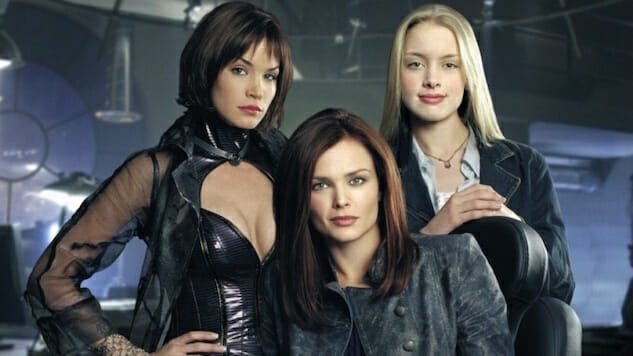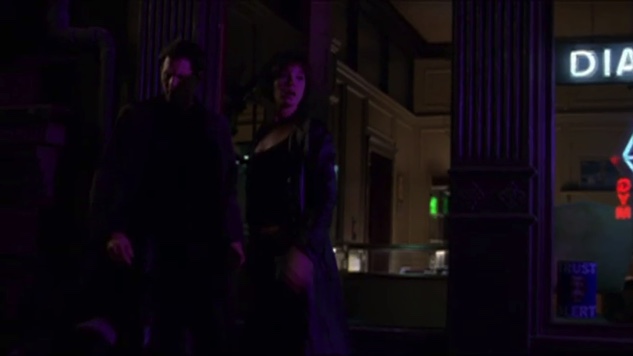ICYMI: Birds of Prey Was The WB’s Sexy, Girl-Powered Counterpart to Smallville
That Was Its Blessing and Curse
Photo Courtesy of WBTV
In the fall of 2001, The WB had a hit on its hands with the debut of its superhero origin series, Smallville. Telling the story of a young Clark Kent (Tom Welling)—who started off as best friends with a pre-heel-turn Lex Luthor (Michael Rosenbaum)—Smallvillepremiered to 8.4 million viewers, setting the record for the network’s highest-rated series debut ever. Today, this would be grounds for a connected spin-off.
Instead, Smallville executive producers Mike Tollin, Brian Robbins, and Joe Davola followed up Smallville with Birds of Prey. Instead of involving Smallville showrunners Al Gough, Miles Millar or anyone who wrote for Smallville at all, it was developed by Laeta Kalogridis (now known for Shutter Island, Alita: Battle Angel and Altered Carbon). She was fired from the show after the original pilot was shot but remained credited as an executive producer. Of her experience on Birds of Prey—the first project she’s credited for on IMDB, having worked on unproduced feature film assignment work prior—Kalogridis told The Hollywood Reporter:
“Birds of Prey was a project that I loved from a comic book perspective, but I also found that I did not understand or appreciate the difference in sheer volume between network television and movies. Say you’ve got about nine months to make about 22 hours of filmed entertainment, versus about maybe two years to make two hours of filmed entertainment. Like a great many other feature writers, I did not have a real understanding of the way that the beast had to be fed in order for that process to work optimally creatively. So I learned a huge amount on that show.”
Birds of Prey was also a far darker approach to the loose adaptation of DC Comics source material than Smallville. It was also more interested in actually being a comic-book show, in its own canon-breaking way. Set in the understandably darker New Gotham City—a revamped version of the typical Batman playground of Gotham City, due to an earthquake that destroyed all of Old Gotham and sent it underground—two of its lead characters were already accomplished superheroes who were comfortable with that role and the third character was the fish out of water who wanted to join in on that superhero lifestyle. While Smallville refered to metahumans as “freaks” until about its fifth season, Brids of Prey referred to them as “metas” from the very beginning. The series’ heroic line-up consisted of Oracle/Barbara Gordon fka Batgirl (Dina Meyer), Huntress/Helena Kyle (Ashley Scott), and Dinah Redmond/Lance (Rachel Skarsten, who was actually 16 years old when she was cast). In the comics, Dinah Lance was Black Canary, but—in addition to the change of making Helena a meta and also going the comic Earth-2 route of her being the daughter of Selina Kyle (Catwoman) and Bruce Wayne (Batman)— The WB’s Birds of Prey made Dinah a telepathic, telekinetic meta, later revealing that her mother Carolyn (Lori Loughlin, who only now as a convicted felon has the street cred to pull off the leather jacket she wore in the series) was the real Black Canary. As the voiceover by Wayne butler Alfred Pennyworth (Ian Abercrombie) before every episode explained:
“Legend tells of a caped crusader, Batman, guardian of New Gotham, and his one true love, Catwoman, the queen of the criminal underworld. Their passion left behind something extraordinary: a daughter, Huntress. Half metahuman, she has taken up her father’s mantle and fights to protect the innocent and helpless. Joining her in this struggle: Oracle, once Batman’s protégé, Batgirl, she was caught in the crossfire of the war between Batman and Joker. Now she fights crime a different way, a master of the cyber-realms and trainer to heroes. Together, they have taken in Dinah, a metahuman herself, with powers that she is only beginning to explore. These three are the protectors of New Gotham: the Birds of Prey. My name is Alfred Pennyworth and this is their story.”
Watching the pilot with 2019 eyes,it’s a disappointing beginning for what would become a solid series about women. After the post-introduction fridging of Selina Kyle and the “Batman: The Killing Joke” origin of Barbara’s paralysis, there’s an attempted sexual assault on Dinah (by a character notably played by Aaron Paul) and Helena being drugged (with her mind then invaded) by an older man she trusts. In a 2019, #MeToo context and a strong desire to get away from the type of “empowerment” that would be seen in a movie like Suckerpunch, it didn’t make for a fun rewatch, other than the moment that Huntress told Detective Reese (Shemar Moore), “I am the weapon.”
Actually, the other highlights of that particular viewing were the very 2002 music cues (Oasis’ “Stop Crying Your Heart Out,” Michelle Branch’s “All You Wanted”) and the fact that, visually, the episode was at its best when it was doing something that actually was ahead of its time: the black and white, noir world in which the villain of the week navigated victims’ subconscious, which was very Sin City before the movie adaptation of the graphic novel came out in 2005.

However, rewatching the rest of the series left a better taste in my mouth, even though Birds of Prey, admittedly, went to the early aughts, Charmed and Charlie’s Angels school of feminism and girl power, specially when it came to the characters’ wardrobes—specifically Helena/Huntress and Dr. Harleen Quinzel/Harley Quinn (Mia Sara). This was very clear in the case of Helena/Huntress, as the only difference between her everyday wardrobe and her superhero wardrobe was that the latter was all black. (Dinah dressed very much like a normal teen, and that only changed once she officially became a sidekick and got her own leather for out in the field.) In the episode “Split,” it opened with Huntress wearing what can only be considered sexy Angel (of Buffy the Vampire Slayer and Angel) cosplay… only for Kristoffer Polaha, of all WB and one-season show staples, to show up in the same Angel cosplay, right down to the leather pants.

(Birds of Prey would have been better served finding inspiration for its fight scenes from Buffy and other pioneers like Alias instead of hewing to the era-appropriate wire-fu.)
-

-

-

-

-

-

-

-

-

-

-

-

-

-

-

-

-

-

-

-

-

-

-

-

-

-

-

-

-

-

-

-

-

-

-

-

-

-

-

-









































